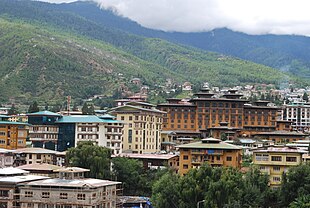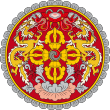Economy of Bhutan
 Thimphu is the largest economic centre of Bhutan | |
| Currency | ngultrum (BTN) |
|---|---|
| 1 Jan – 31 December | |
Trade organizations | SAFTA |
Country group |
|
| Statistics | |
| Population | |
| GDP | |
| GDP rank | |
GDP growth |
|
GDP per capita | |
GDP per capita rank | |
GDP by sector |
|
| 4.2% (2020 est.)[4] | |
Population below poverty line | |
| 37.4 medium (2017, World Bank)[9] | |
Labor force | |
Labor force by occupation |
|
| Unemployment | |
Main industries | cement, wood products, processed fruits, alcoholic beverages, calcium carbide, tourism |
| External | |
| Exports | |
Export goods | electricity (to India), ferrosilicon, cement, cardamom, calcium carbide, steel rods/bars, dolomite, gypsum |
Main export partners | |
| Imports | |
Import goods | fuel and lubricants, airplanes, machinery and parts, rice, motor vehicles |
Main import partners | |
FDI stock |
|
Gross external debt | |
| Public finances | |
| −3.4% (of GDP) (2017 est.)[6] | |
| Revenues | 655.3 million (2017 est.)[6] |
| Expenses | 737.4 million (2017 est.)[6][note 1] |
| Economic aid | $985 million (India) (2015-16) |
All values, unless otherwise stated, are in US dollars. | |
The economy of Bhutan, one of the world's smallest and least developed countries, is based on agriculture and forestry, which provide the main livelihood for more than 60% of the population. Agriculture consists largely of subsistence farming and animal husbandry. Rugged mountains dominate the terrain and make the building of roads and other infrastructure difficult and expensive.
The economy is closely aligned with India's through strong trade and monetary links and dependence on India's financial assistance. Most production in the industrial sector is of the cottage industry type. Most development projects, such as road construction, rely on Indian migrant labour. Model education, social, and environment programs are underway with support from multilateral development organisations.
Each economic program takes into account the government's desire to protect the country's environment and cultural traditions. For example, the government, in its cautious expansion of the tourist sector, encourages visits by upscale, environmentally conscientious tourists. Detailed controls and uncertain policies in areas such as industrial licensing, trade, labour, and finance continue to hamper foreign investment. Hydropower exports to India have boosted Bhutan's overall growth, even though GDP fell in 2008 as a result of a slowdown in India, its predominant export market.
Macro-economic trend
This is a chart of trend of gross domestic product of Bhutan at market prices [1] by the International Monetary Fund:
| Year | GDP (millions of BTN) | GDP (millions of USD) |
|---|---|---|
| 1985 | 2,166 | 175 |
| 1990 | 4,877 | 279 |
| 1995 | 9,531 | 294 |
| 2000 | 20,060 | 460 |
| 2005 | 36,915 | 828 |
| 2008 | 45,000 | 1280 |
Bhutan's hydropower potential and its attraction for tourists are key resources. The Bhutanese Government has made some progress in expanding the nation's productive base and improving social welfare.
In 2004, Bhutan became the first country in the world to ban smoking and the selling of tobacco.
See also
- Agriculture in Bhutan
- Banking in Bhutan
- Mining in Bhutan
- Fishing in Bhutan
- Forestry in Bhutan
- Bhutanese ngultrum, currency
References
 This article incorporates public domain material from The World Factbook. CIA.
This article incorporates public domain material from The World Factbook. CIA. This article incorporates public domain material from U.S. Bilateral Relations Fact Sheets. United States Department of State.
This article incorporates public domain material from U.S. Bilateral Relations Fact Sheets. United States Department of State.
- ^ "World Economic Outlook Database, April 2019". IMF.org. International Monetary Fund. Retrieved 29 September 2019.
- ^ "World Bank Country and Lending Groups". datahelpdesk.worldbank.org. World Bank. Retrieved 29 September 2019.
- ^ "Population, total - Bhutan". data.worldbank.org. World Bank. Retrieved 15 October 2019.
- ^ a b c d e "World Economic Outlook Database, October 2019". IMF.org. International Monetary Fund. Retrieved 20 October 2019.
- ^ "Global Economic Prospects, June 2020". openknowledge.worldbank.org. World Bank. p. 98. Retrieved 24 June 2020.
- ^ a b c d e f g h i j k l m n "The World Factbook". CIA.gov. Central Intelligence Agency. Retrieved 25 January 2019.
- ^ "Poverty headcount ratio at national poverty lines (% of population) - Bhutan". data.worldbank.org. World Bank. Retrieved 21 March 2020.
- ^ "South Asia Economic Focus, Spring 2020 : The Cursed Blessing of Public Banks". openknowledge.worldbank.org. World Bank. p. 92. Retrieved 14 April 2020.
- ^ "GINI index (World Bank estimate)". data.worldbank.org. World Bank. Retrieved 25 January 2019.
- ^ "Human Development Index (HDI)". hdr.undp.org. HDRO (Human Development Report Office) United Nations Development Programme. Retrieved 11 December 2019.
- ^ "Inequality-adjusted HDI (IHDI)". hdr.undp.org. UNDP. Retrieved 22 May 2020.
- ^ "Labor force, total - Bhutan". data.worldbank.org. World Bank. Retrieved 5 March 2020.
- ^ "Employment to population ratio, 15+, total (%) (national estimate) - Bhutan". data.worldbank.org. World Bank. Retrieved 5 March 2020.
- ^ "Export Partners of Bhutan". CIA World Factbook. 2015. Retrieved 26 July 2016.
- ^ "Import Partners of Bhutan". CIA World Factbook. 2015. Retrieved 26 July 2016.
External links
- Global Economic Prospects: Growth Prospects for South Asia The World Bank, 13 December 2006
Notes
- ^ the Government of India finances nearly one-quarter of Bhutan's budget expenditures

